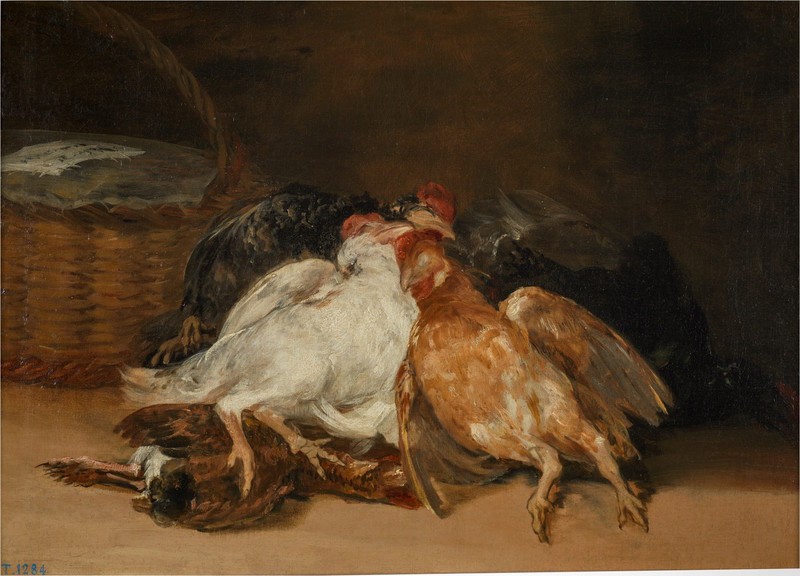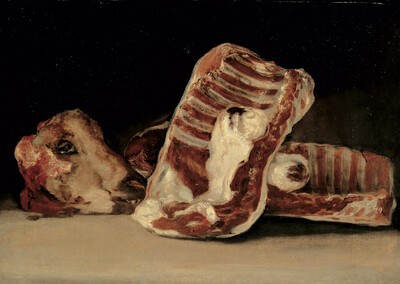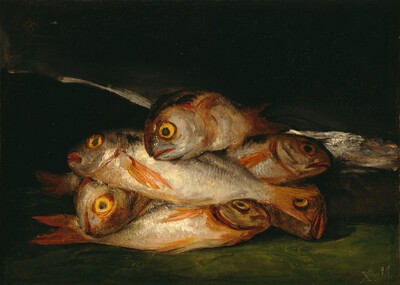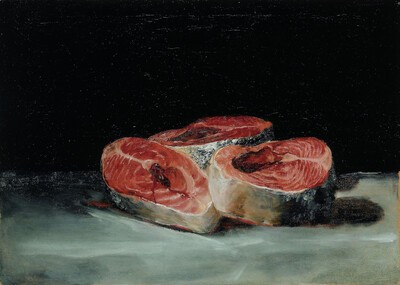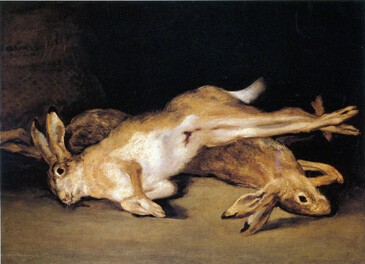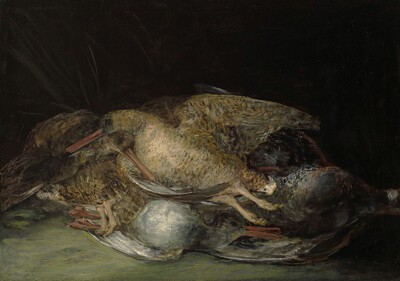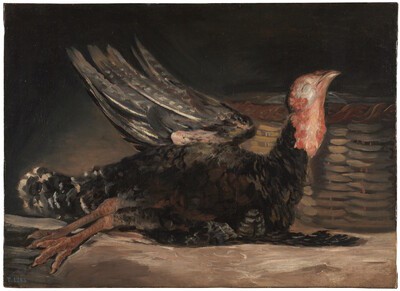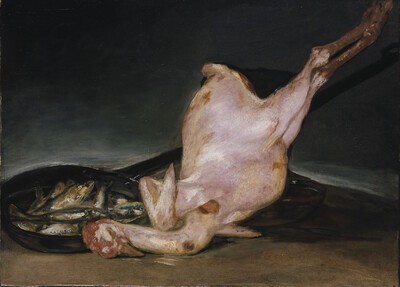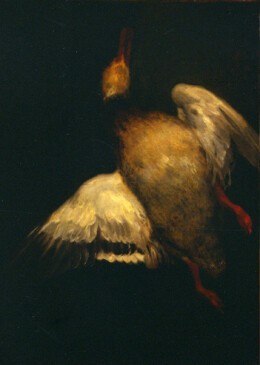- Cronología
- 1808 - 1812
- Ubicación
- The Prado National Museum. Madrid, Madrid, Spain
- Dimensiones
- 46 x 64 cm
- Técnica y soporte
- Oil on canvas
- Reconocimiento de la autoría de Goya
- Documented work
- Titular
- El Prado National Museum
- Ficha: realización/revisión
- 21 Apr 2010 / 15 Jun 2023
- Inventario
- (P00752)
For more information, see Pieces of Lamb.
Javier Goya inherited this series of still lifes from his father, and in turn left them to his own son, Mariano. When he was unable to repay a loan made to him by the Count of Yumuri, Carabanchel, Mariano gave this set of paintings as security, and in the end the works became the property of the count. When the Count of Yumuri died in 1865 the series of still lifes was sold. Today these works are scattered between different museums and institutions around the world, and some of the paintings have now been lost.
This canvas, together with Dead Turkey, was acquired for the Prado Museum by the Spanish Ministry of Development on 20 March 1900, with the works' owner, Rafael García Palencia, receiving three thousand pesetas for each of them. The day after it was purchased, the painting entered the collection of the Madrid museum, which mentions it for the first time in the 1900 edition of its catalogue.
In front of a dark background, Goya has placed several hens, seemingly carelessly piled up one on top of the other. Just as in Dead Turkey, a basket has been used as a spatial reference.
The sense of drama in this work is heightened by the light, which is focussed on the lifeless bodies of the animals. This device of piles of corpses, which is used in several paintings in the series, can also be seen in some of the etchings in the Disasters of War series, suggesting a connection between the still lifes and Goya's prints inspired by the Spanish War of Independence. As López Rey points out, this work has particularly strong ties to plate no. 22 of the series, entitled All this and more (Tanto y más), which features a heap of human bodies.
For more information, see Pieces of Lamb.
-
GoyaPalacio de PedralbesBarcelona1977from April 12th to June 30th 1977cat. 39
-
Da El Greco a GoyaFlorence1986cat. 86
-
Pintura española de bodegones y floreros de 1600 a GoyaMuseo Nacional del PradoMadrid1983consultant editor Alfonso E. Pérez Sánchez, November 1983 to January 1984cat. 188
-
GoyaNationalmuseumStockholm1994consultant editors Juan J. Luna and Görel Cavalli-Björkman. From October 7th 1994 to January 8th 1995cat. 34
-
Goya. 250 AniversarioMuseo Nacional del PradoMadrid1996consultant editor Juan J. Luna. From March 29th to June 2nd 1996cat. 134
-
Goya, un regard librePalais de Beaux ArtsLille1998from December 12th 1998 to March 14th 1999. Exhibited also at The Philadelphia Museum, Philadelphia, April 17th 1999 to July 11th 1999, consultant editor Arnauld Brejon de Lavergnée and Joseph J. Rishel in collaboration with Manuela B. Mena Marquéscat. 43
-
Goya en tiempos de guerraMuseo Nacional del PradoMadrid2008consultant editor Manuela B. Mena Marqués, from April 14th to July 13th 2008cat. 59
-
Goya luces y sombrasCaixaForumBarcelona2012consultant editors José Manuel Matilla and Manuela B. Marqués. From March 16th to June 24th 2012cat. 54
-
L'œuvre peint de Goya. 4 volsParís1928-1950p. 214, cat. 176
-
Vie et ouvre de Francisco de GoyaParísOffice du livre1970p. 262, cat. 905
-
BarcelonaPolígrafa1970vol. I, p. 352, cat. 590
-
L’opera pittorica completa di GoyaMilanRizzoli1974p. 123, cat. 506
-
Francisco de Goya, 4 vols.ZaragozaCaja de Ahorros de Zaragoza, Aragón y Rioja1980-1982vol. III, p. 187
-
Goya. Arte e condizione umanaNaplesLiguori editore1990pp. 158-160
-
El bodegón español de Velázquez a GoyaMadridEdiciones El Viso1995pp. 175, 176, 177, 180, 184, cat. 68
-
Goya. 250 AniversarioMadridMuseo del Prado1996pp. 228 (il.), p.405, cat. 133
-
Goya en tiempos de guerraMadridMuseo Nacional del Prado2008pp. 240 y 244, cat. 59
-
Los mundos de Goya (1746-1828)BarcelonaLunwerg2008pp. 159-160, cat. 90
